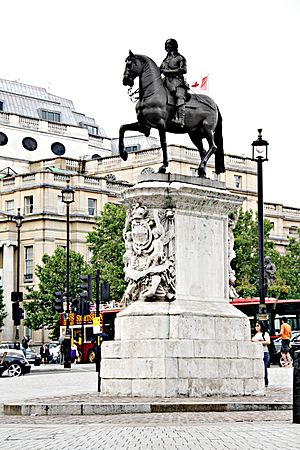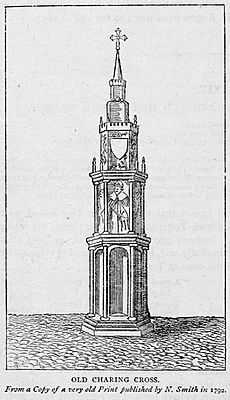Equestrian statue of Charles I, Charing Cross facts for kids
Quick facts for kids Charles I |
|
|---|---|

The statue in 2009
|
|
| Artist | Hubert Le Sueur |
| Year | 1633 |
| Type | Equestrian statue |
| Medium | Bronze |
| Subject | Charles I of England |
| Location | London, WC2 United Kingdom |
|
Listed Building – Grade I
|
|
| Official name | Statue of Charles I |
| Designated | 9 January 1970 |
| Reference no. | 1357291 |
| 51°30′26″N 0°07′40″W / 51.50734°N 0.12768°W | |

The equestrian statue of King Charles I at Charing Cross in London, England, is a famous artwork. It was made by the French sculptor Hubert Le Sueur. The statue was likely cast (shaped from melted metal) in 1633, while Charles I was still alive. It is the oldest bronze statue in London and is seen as the very center of the city.
The statue stands where an Eleanor cross once was. This cross was built by King Edward I and stood for over 350 years until 1647. Charing Cross is officially used to mark the center of London. A special plaque near the statue shows that road signs measure distances to London from this exact spot. The statue faces down Whitehall towards Banqueting House. This is where King Charles I was executed in 1649.
This statue was the first of its kind in England to be made in the Renaissance style. It was ordered by Charles I's chief financial officer, Richard Weston. He wanted it for the garden of his country home in Roehampton. After the English Civil War, the statue was sold to a metalworker. He was supposed to melt it down. But he secretly hid it instead until the king was restored to power. In 1675, the statue was placed in its current important spot in central London. The detailed stone base (called a plinth) was also made around that time.
Contents
About the Statue of Charles I
The statue shows Charles I of England riding a horse. The king is wearing a special type of armor that covers part of his body. He does not have a helmet on his head. A scarf is tied across his chest, forming a bow on his right shoulder. King Charles holds a short stick (a baton) in his right hand. He holds the horse's reins with his left hand. The artist paid close attention to the details of his armor and clothes. However, the king's face looks more like a mask, without much individual detail.
History of the Charles I Statue
Charles I became king in March 1625, after his father died. In 1629, King Charles I decided to rule without Parliament. The statue was ordered the next year, in 1630.
The agreement for the statue was written in French and English. It is believed that the architect Balthazar Gerbier wrote it. He was building Weston's country house at the time. The statue was supposed to be finished in 18 months, by the summer of 1631. But it took longer to make. The year 1633 is carved on the horse's left front foot. This is likely when the statue was cast.
The English Civil War and the Statue
After the Parliamentary side won the English Civil War, the statue was sold. It went to a metalworker named John Rivet in the Holborn area. Rivet was told by Parliament to break the statue into pieces. But instead, he hid it at his workshop. He showed some broken brass pieces as proof that he had followed orders. For a while, he sold cutlery with brass handles. He told both Royalists (who supported the king) and Parliamentarians that the brass came from the statue.
The Statue's Return to London
After the king was restored to power in England, the statue was found. Jerome Weston, 2nd Earl of Portland discovered it. He complained to the House of Lords. They ordered John Rivet to give the statue back. The king bought the statue. In 1675, it was placed in its current spot. The stone base (plinth) is made of Portland stone and has a carved coat of arms. A mason named Joshua Marshall, who worked for King Charles II, completed this part.
Later Events and Repairs
On October 28, 1844, Queen Victoria visited to open the Royal Exchange. During her visit, the sword and the badge of the Order of the Garter were stolen from the statue.
During the Second World War, the statue was moved for safety. The Ministry of Works stored it at Mentmore Park. Before putting it back, the Ministry repaired the statue. They added a new sword and a new Order of the Garter badge. Also, a bronze plaque was added to the base. This plaque explains that these items were replaced.
In late 1892, a group called the Legitimist Jacobite League of Great Britain and Ireland wanted to place wreaths at the statue. They wanted to do this on the anniversary of Charles I's execution. The Prime Minister, Gladstone, said no. The League tried to lay their wreaths anyway on January 30, 1893. Police were sent to stop them. After some discussion, the League members were allowed to finish their ceremony. Newspapers generally made fun of the League for their actions.
In 1977, the statue's base was cleaned for the first time in 300 years. This work was done by the Department of the Environment and the conservation team at the Victoria and Albert Museum.
Images for kids



